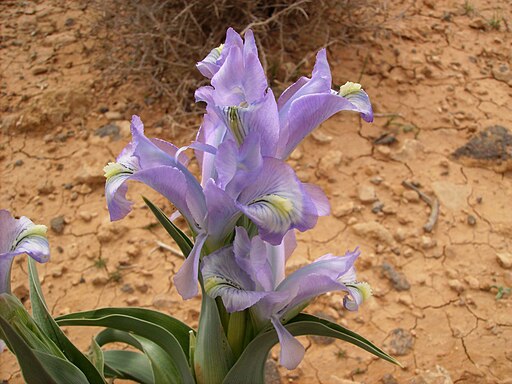Classification System: APG IV
Superregnum: Eukaryota
Regnum: Plantae
Cladus: Angiosperms
Cladus: Monocots
Ordo: Asparagales
Familia: Iridaceae
Subfamilia: Iridoideae
Tribus: Irideae
Genus: Iris
Subgenus: I. subg. Scorpiris
Species: Iris aucheri
Name
Iris aucheri (Baker) Sealy, Kew Bull. 4: 562 (1950) [1949 publ. 1950].
Synonyms
Basionym
Xiphion aucheri Baker, J. Bot. 9: 110 (1871).
Homotypic
Juno aucheri (Baker) Klatt, Bot. Zeitung (Berlin) 30: 498 (1872).
Thelysia fumosa Decne., Bull. Soc. Bot. France 20: 304 (1873), nom. superfl.
Iris fumosa Boiss. & Hausskn. in P.E.Boissier, Fl. Orient. 5: 123 (1882), nom. superfl.
Juno fumosa Kamelin, Florogenet. Anal. Estest. Fl. Gorn. Sred. Azii: 252 (1973), nom. superfl.
Iris aucheri var. fumosa Bolt., Phytotaxa 303(2): 135 (2017), nom. inval.
Heterotypic
Iris sindjarensis Boiss. & Hausskn. in P.E.Boissier, Fl. Orient. 5: 122 (1882).
Juno sindjarensis (Boiss. & Hausskn.) Kamelin, Florogenet. Anal. Estest. Fl. Gorn. Sred. Azii: 252 (1973).
Iris assyriaca W.Irving, Garden (London, 1871-1927) 69: 195 (1906).
Iris nusairiensis Mouterde, Nouv. Fl. Liban Syrie 1: 311 (1966).
Juno nusairiensis (Mouterde) Soják, Cas. Nár. Mus., Odd. Prír. 150: 138 (1982).
Distribution
Native distribution areas:
Continental: Asia-Temperate
Regional: Caucasus
Transcaucasus.
Regional: Western Asia
Iran, Iraq, Lebanon-Syria, Palestine, Turkey.
References: Brummitt, R.K. 2001. TDWG – World Geographical Scheme for Recording Plant Distributions, 2nd Edition
References
Primary references
Sealy, J.R., 1950. Kew Bull. 4: 562.
Additional references
Danin, A. 2004. Distribution Atlas of Plants in the Flora Palaestina Area. 520 pp., Jerusalem: Israel Academy of Sciences and Humanities. ISBN 965-208-167-1. Reference page.
Links
Govaerts, R. et al. 2022. Iris aucheri in World Checklist of Selected Plant Families. The Board of Trustees of the Royal Botanic Gardens, Kew. Published online. Accessed: 2022 Feb 09. Reference page.
Hassler, M. 2022. Iris aucheri. World Plants: Synonymic Checklists of the Vascular Plants of the World In: Roskovh, Y., Abucay, L., Orrell, T., Nicolson, D., Bailly, N., Kirk, P., Bourgoin, T., DeWalt, R.E., Decock, W., De Wever, A., Nieukerken, E. van, Zarucchi, J. & Penev, L., eds. 2022. Species 2000 & ITIS Catalogue of Life. Published online. Accessed: 2022 Feb 09. Reference page.
Tropicos.org 2022. Iris aucheri. Missouri Botanical Garden. Published online. Accessed: 09 Feb 2022.
International Plant Names Index. 2022. Iris aucheri. Published online. Accessed: Feb 09 2022.
USDA, ARS, Germplasm Resources Information Network. Iris aucheri in the Germplasm Resources Information Network (GRIN), U.S. Department of Agriculture Agricultural Research Service. Accessed: 6 Sep 2006.
Vernacular names
azərbaycanca: Auxer süsəni
Deutsch: Aucher-Schwertlilie
فارسی: سوسن اوشيه
Iris aucheri, the Aucher-Éloy iris, is a species of flowering plant in the family Iridaceae. It is a bulbous perennial in the Juno group of irises (multiple flowers per plant).
Description
Iris aucheri grows to 25 cm (10 in) tall, with crowded lanceolate (lance-shaped) leaves, producing several flowers in late winter or early spring.
The flowers may be white, pale blue or dark blue, with a yellow splash on the falls. It has a violet-like scent.
Biochemistry
As most irises are diploid, having two sets of chromosomes, this can be used to identify hybrids and classification of groupings.[2] It has a chromosomal count of 2n = 24.[3] A study in 2014, was carried out on various species of iris DNA, it found that I. iberica subsp. elegantissima had a purity value of 2.80, compared to 1.26 of Iris aucheri.
Taxonomy
The Latin specific epithet aucheri commemorates the 19th century French botanist Pierre Martin Rémi Aucher-Éloy.[4]
It was first described as Xiphion aucheri by Baker and then published as Iris aucheri by Sealy in Kew Bull. page 562 in 1950.[5][6]
There is a known variant Iris aucheri var. fumosa which was published in 2017.[7]
Distribution and habitat
It is native to temperate Western Asia.[5][8]
Range
It is found in Turkey, Iraq, Iran, Syria and Jordan.[5][8]
Cultivation
Iris aucheri is cultivated as an ornamental plant in gardens for its showy flowers. It requires neutral or slightly alkaline soil in a sheltered, frost-free spot, or it can be grown in an unheated greenhouse or conservatory, in the UK.[9][10]
It is hardy down to USDA Zone 6.[8] In the UK, it has been given a hardiness rating by the RHS of H4: −15 °C (5 °F) (hardy in most locations).[11]
This plant species has gained the Royal Horticultural Society's Award of Garden Merit.[11][12]
References
"Iris aucheri". International Plant Names Index (IPNI). Retrieved 23 June 2013.
Austin, Claire (2005). Irises; A Garden Encyclopedia. Timber Press. p. 18. ISBN 0881927309.
Kamari, G.; Felber, F.; Garbari, F., eds. (1999). "Mediterranean chromosome number reports - 9" (PDF). Flora Mediterranea. 9. Retrieved 16 October 2015.
Harrison, Lorraine (2012). RHS Latin for gardeners. United Kingdom: Mitchell Beazley. p. 224. ISBN 9781845337315.
"Taxon: Iris aucheri (Baker) Sealy". npgsweb.ars-grin.gov. Retrieved 2 June 2020.
"Iris aucheri | International Plant Names Index". www.ipni.org. Retrieved 2 June 2020.
"Iris aucheri var. fumosa | International Plant Names Index". www.ipni.org. Retrieved 2 June 2020.
"IRIS FLEUR-DE-LYS Iridaceae (Iris family)". www.hillkeep.ca. 12 May 2008. Retrieved 23 August 2014.
RHS A-Z encyclopedia of garden plants. United Kingdom: Dorling Kindersley. 2008. p. 1136. ISBN 978-1405332965.
"Juno irises A-I". Pacific Bulb Society. Retrieved 23 June 2013.
"RHS Plant Selector - Iris aucheri". Retrieved 19 February 2020.
"AGM Plants - Ornamental" (PDF). Royal Horticultural Society. July 2017. p. 53. Retrieved 13 March 2018.
Retrieved from "http://en.wikipedia.org/"
All text is available under the terms of the GNU Free Documentation License


